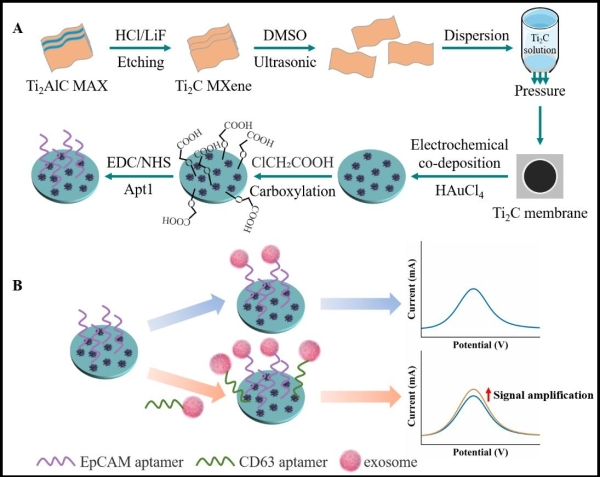A new electrochemical sensor based on nitride MXene material for the identification and detection of exosomes
As a lipid bilayer membrane vesicle with a diameter of about 30-150 nm, the exosomes can be secreted by almost all cells and are widely distributed in human body fluids. The exosomes carry a variety of substances of cell origin, such as membrane proteins, nucleic acids, lipids, etc. They play a crucial role in the occurrence, development and metastasis of tumors, and are important markers in the clinical diagnosis of early cancer. Electrochemical methods have been widely used in clinical diagnosis, biosensors, environmental monitoring and so on because of their strong stability, high sensitivity and easy operation. The highly sensitive and accurate detection of exosomes by electrochemical biosensor technology is of great significance for early diagnosis, curative effect evaluation and prognosis analysis of cancer.
Recently, researchers from Suzhou Institute of Biomedical Engineering Technology, Chinese Academy of Sciences and Chongqing Institute of Green and Intelligent Technology, Chinese Academy of Sciences have developed a new electrochemical sensor based on two-dimensional transition metal carbon/nitride MXene material for the identification and detection of exosomes. As a new two-dimensional material, MXene has large specific surface area, high conductivity and strong catalytic ability. The research on this material has enriched its applications in catalysis, capacitors, biosensors, imaging and other fields.
In this study, researchers prepared two-dimensional mxene planar films by vacuum assisted method, and loaded gold (AU) nanoarrays on the surface of the two-dimensional films by electrochemical applied potential to obtain Au mxene two-dimensional composite films. On the one hand, this method uses MXene two-dimensional materials to build a membrane, which can load a large number of epithelial cell adhesion molecule protein aptamers, specifically recognizing and capturing exosomes; On the other hand, the exosomes secreted by lung cancer cells (A549) were separated and purified by ultracentrifugation, and modified with lysosome related membrane protein aptamers, which could fill the unbound active sites on the surface of the composite membrane, further amplifying the detection signal. The results show that the detection limit of the electrochemical sensor can reach 58 per milliliter, and it has good repeatability, wide detection range and high sensitivity. This research provides a new highly sensitive platform for accurate detection of exosomes, and also broadens the application of two-dimensional materials in the field of biosensors.
Relevant research achievements were published on Biosensors and Bioelectronics under the title of Hierarchical Au nanoarrays functionalized 2D Ti2CTx MXene components for the detection of exosomes isolated from human lung cancer cells. The research work was supported by the National Key R&D Plan, the National Natural Science Foundation of China, the Natural Science Foundation of Jiangsu Province, etc.

Schematic diagram of two-dimensional material composite membrane used for exocrine body detection

